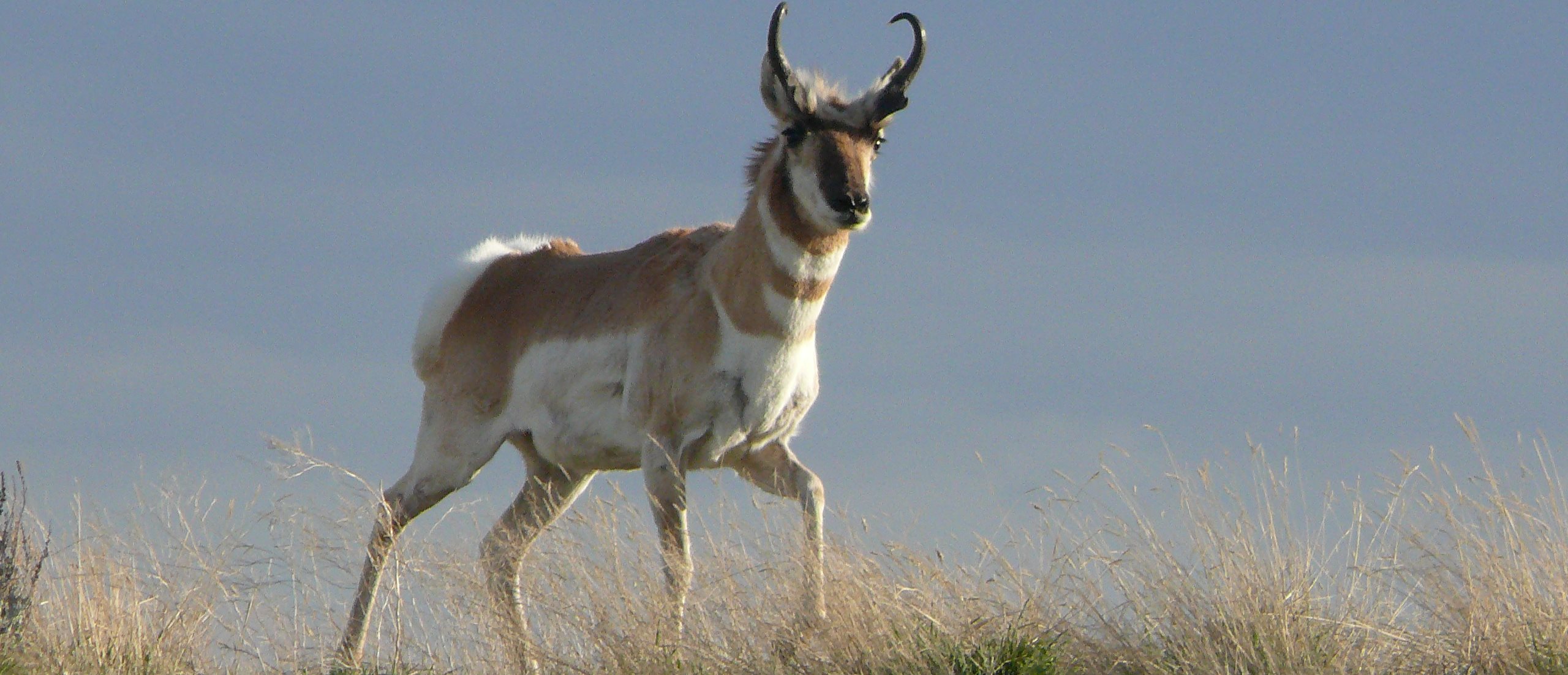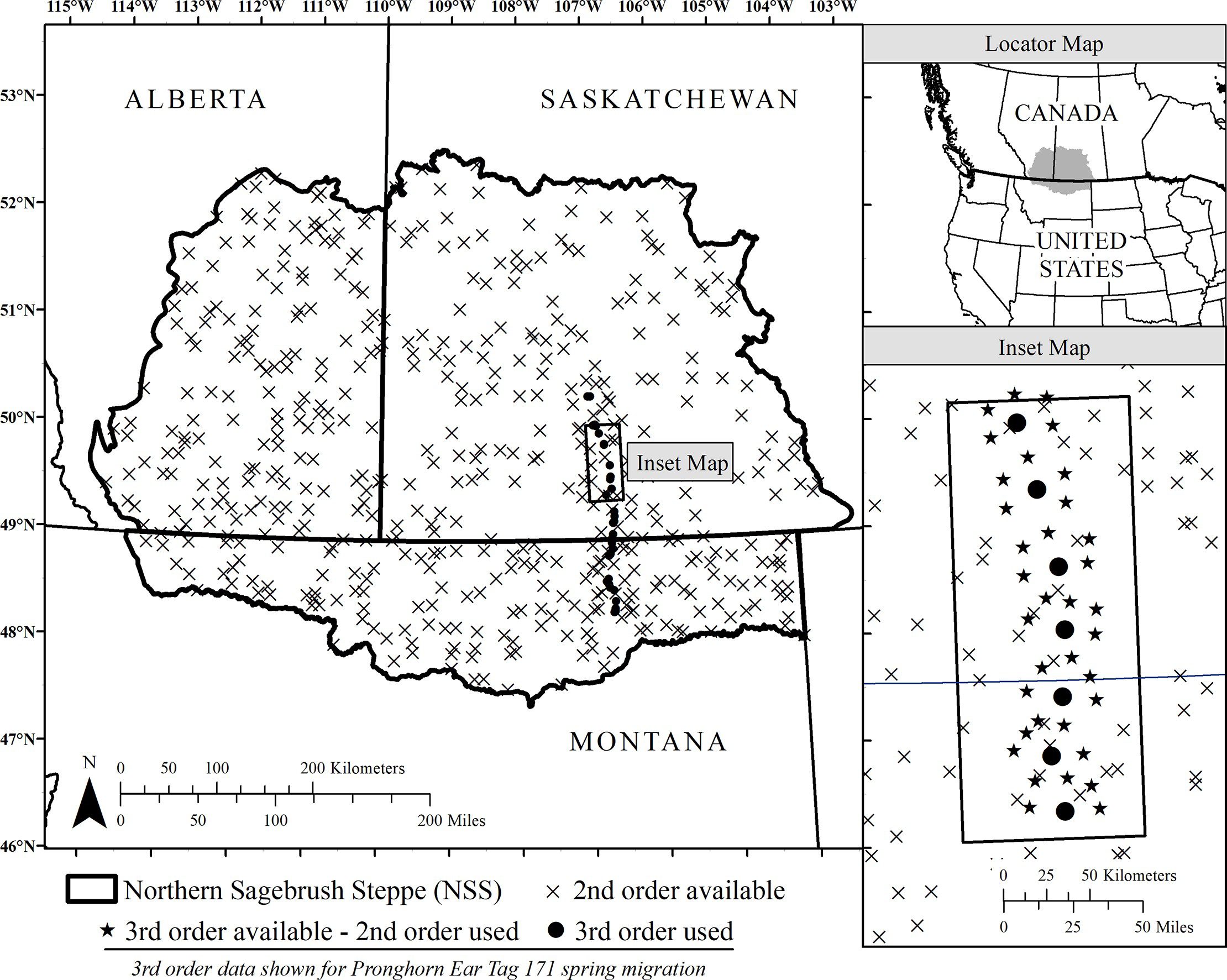← Back
Pronghorn migration across borders and human-made landscapes

Mapping of ungulate migration habitat is important for their conservation. Pronghorn are an endemic species of North America (Canada, USA, and Mexico), migrating between different regions. Satellite telemetry helps in modelling what can hinder pronghorn migration and in taking steps to smooth their paths.
A unique species
The pronghorn (Antilocapra americana) is the only representant of its genus, resembling an antelope but more akin to giraffes. It is indigenous to North America and found from Canada (southern Saskatchewan and Alberta) to Mexico (Sonora and San Luis Potosí), through the United States (North Dakota through central Texas west to coastal southern California). It was nearly extinct but is now recovering except for the Sonoran and Mexican subspecies . Pronghorn are often partially migratory: part of the population migrates in spring and fall, while others remain residents. They show a strong sensitivity to anthropogenic factors, especially when migrating, as structures fragment their movement paths (e.g., roads, housing, etc.).
Tracking pronghorn & modelling what can hinder their migration
To better assess what can hinder the pronghorn’s migrations, a study led by several institutions on both sides of the Canadian-USA border used satellite-telemetry retrieved GPS locations to build a habitat model. Using a model enables one to overcome the incomplete or unevenly distributed sampling inherent to the locations. This habitat model was designed at two different scales, one for the migration path neighborhood (‘second-order’), the other for the ‘day-to-day’ shorter movements (‘third-order’) of the animals. Vegetation, land cover, topography, and other natural features, as well as human infrastructure data were also integrated into the model.
185 female pronghorn were equipped with satellite telemetry collars – Argos in part — during the winters of 2003-2010. The area of the study encompassed 315,876 km2 of the prairie regions of Alberta, Saskatchewan, Canada and Montana, USA, a landscape of open plains and rolling hills. Locations from 170 animals-equivalent of annual movement were used (94 actual individuals), with 55% being migratory and 45% residents.
More info about animal tracking with Argos

An example of the hierarchically nested design for one individual during spring migration across the Northern Sagebrush Steppe. Pronghorn ‘second-order’ selection compares migratory neighborhoods to the entire study area whereas ‘third-order’ selection compares migratory pathway relocations to the migratory neighborhood. This original map was created using ArcGIS Desktop version 10.4.1 (ESRI, Inc., Redlands, California, USA) and includes vector data from Natural Earth (“Admin 1 –States, Provinces”) which complies with CC BY 4.0 license; available from https://protect-us.mimecast.com/s/pxvaCxkVBDILmvE2uAfAL2?domain=naturalearthdata.com (from [Jakes et al., 2020])
Model result analysis & perspectives: taking steps to smooth their paths
As land cover types, the pronghorn seem to prefer native grasslands (which enable them to maintain their energy reserves) and avoid conifer forest during both migrations. Concerning human infrastructures, the ruminants seem to avoid roads during both migrations and oil and gas wells during the spring migration, but this is visible only at the broad scale, not at the fine scale.
Recommendations are that protecting the native grasslands is a conservation priority. The sensitivity of migratory pronghorn to road raises a potential problem for them, since roads might block their optimal path. Facilitating their movements across roads is thus important. The cooperation on both sides of the Canada-USA border should also be encouraged, with data sharing and joint management of such species.
Such a methodology would also be of interest in any region where ungulates migrate, especially whenever authorities are scattered between different administrations.
Reference
- Jakes AF, DeCesare NJ, Jones PF, Gates CC, Story SJ, Olimb SK, et al. (2020) Multi-scale habitat assessment of pronghorn migration routes. PLoS ONE 15(12): e0241042. https://doi.org/ 10.1371/journal.pone.0241042
Photo: A pronghorn (credit P. Jones – Alberta Conservation Association)
